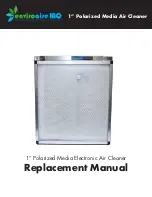
5
5
- 12
W-2WAY ECO-i SYSTEM
Trouble Diagnosis
4. W-2WAY ECO-i Alarm Codes
F04, F05, F22 Alarm
Alarm code
F04, F05, F22
Alarm meaning
Compressor 1 discharge temperature sensor trouble, compressor 2 discharge temperature
sensor trouble, Compressor 3 discharge temperature sensor trouble.
Alarm conditions
(1) Discharge temp. of 100°C or higher was detected 20 minutes or more after that compressor
stopped operating.
(2) Discharge temp. of 70°C or higher was detected after all compressors had been stopped for
60 minutes or longer.
(3) A/D step is 10 steps or less (short circuit).
Probable cause
(1) Sensor malfunction
Sensor element malfunction
Sensor wiring is partially disconnected, resulting in increased electrical resistance.
This alarm does not occur when the wiring is cut or when the connector is not connected to
the outdoor unit PCB.
(2) Crossed wiring or installation error
The discharge temperature sensor of that compressor is connected to the discharge tube
of the other compressor.
The connector for the discharge temperature sensor of the problem compressor is
connected to the outdoor unit PCB connector for the other compressor.
(3) Outdoor unit PCB failure
(4) The check valve on the discharge tube for that compressor is wet.
(5) An air short blockage in the area around the outdoor unit has increased the outdoor unit
ambient temperature, reducing the cooling effects after the compressor stops.
(6) There is a cause that results in P03, P17, or P02 alarm.
(7) Electrical noise
•
•
•
•
Check
(1) Sensor malfunction and outdoor unit PCB failure
Trouble: • Constantly indicates a high temperature.
When monitoring software or other means are used for monitoring, the discharge
temperature at times fl uctuates suddenly and wildly.
In some cases, the precise temperature may not be known, even when monitoring
software is used.
Check:
• Wiggle the sensor and check whether the trouble continues.
Check whether the connector is partially disconnected from the PCB.
An F04 alarm will not result if the connector is completely disconnected (circuit is
open).
If the cause is still uncertain, check the following to determine whether a sensor or
PCB failure has occurred.
Step 1: Connect the other compressor discharge sensor, or a discharge sensor where
the F04 alarm has not occurred, to the connector for this compressor on the
PCB. Measure the temperature at the same point (a location where temperature
fl uctuations are small), and check whether there is a temperature difference.
Difference
→
A PCB or sensor failure is possible.
No difference
→
PCB and sensor are normal.
Step 2: If an abnormality was found at Step 1, connect the problem compressor
sensor to the other compressor connector on the PCB, or to the PCB
connector of a device where the F04 alarm has not occurred. Measure the
temperature at the same point (a location where temperature fl uctuations are
small), and check whether there is a temperature difference.
Difference
→
Sensor
failure.
No difference
→
PCB failure.
It is convenient at this time to have a discharge temperature sensor on hand.
(2) Crossed wiring or installation error
Trouble:
Although the other compressor is operating and this compressor is stopped, the
discharge temperature of the other compressor does not increase and the discharge
temperature of this compressor rises.
*
The discharge temperature remains high immediately after the compressor stops. Wait
for some time after the compressor stops and observe.
Check:
Check for crossed wiring and installation errors.
•
•
•
•
Continued
W-2WAY ECO-i SYSTEM̲Eng5.indd 12
W-2WAY ECO-i SYSTEM̲Eng5.indd 12
2008/09/02 17:46:43
2008/09/02 17:46:43
















































